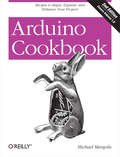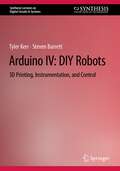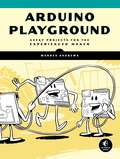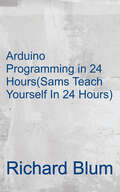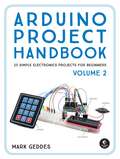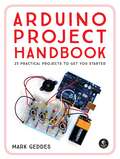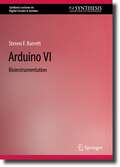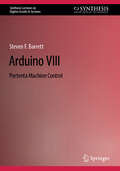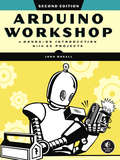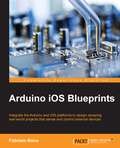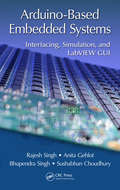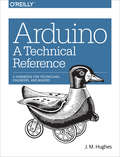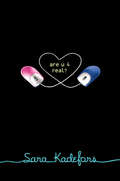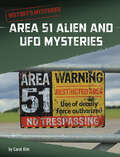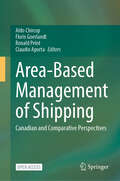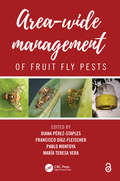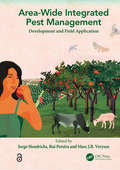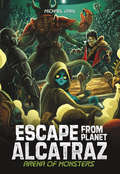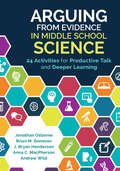- Table View
- List View
Arduino Cookbook: Recipes to Begin, Expand, and Enhance Your Projects (Oreilly And Associate Ser.)
by Brian Jepson Michael Margolis Nicholas Robert WeldinWant to create devices that interact with the physical world? This cookbook is perfect for anyone who wants to experiment with the popular Arduino microcontroller and programming environment. You’ll find more than 200 tips and techniques for building a variety of objects and prototypes such as IoT solutions, environmental monitors, location and position-aware systems, and products that can respond to touch, sound, heat, and light.Updated for the Arduino 1.8 release, the recipes in this third edition include practical examples and guidance to help you begin, expand, and enhance your projects right away—whether you’re an engineer, designer, artist, student, or hobbyist.Get up to speed on the Arduino board and essential software concepts quicklyLearn basic techniques for reading digital and analog signalsUse Arduino with a variety of popular input devices and sensorsDrive visual displays, generate sound, and control several types of motorsConnect Arduino to wired and wireless networksLearn techniques for handling time delays and time measurementApply advanced coding and memory-handling techniques
Arduino Cookbook: Recipes to Begin, Expand, and Enhance Your Projects (Oreilly And Associate Ser.)
by Michael MargolisWant to create devices that interact with the physical world? This cookbook is perfect for anyone who wants to experiment with the popular Arduino microcontroller and programming environment. You'll find more than 200 tips and techniques for building a variety of objects and prototypes such as toys, detectors, robots, and interactive clothing that can sense and respond to touch, sound, position, heat, and light. You don't need experience with Arduino or programming to get started. Updated for the Arduino 1.0 release, the recipes in this second edition include practical examples and guidance to help you begin, expand, and enhance your projects right away--whether you're an artist, designer, hobbyist, student, or engineer. Get up to speed on the Arduino board and essential software concepts quickly Learn basic techniques for reading digital and analog signals Use Arduino with a variety of popular input devices and sensors Drive visual displays, generate sound, and control several types of motors Interact with devices that use remote controls, including TVs and appliances Learn techniques for handling time delays and time measurement Apply advanced coding and memory handling techniques
Arduino Essentials
by Francis PereaIf you are a hobbyist who wants to develop projects based on Arduino as the main microcontroller platform or an engineer interested in finding out what the Arduino platform offers, then this book is ideal for you. Some prior knowledge of the C programming language is required.
Arduino IV: 3D Printing, Instrumentation, and Control (Synthesis Lectures on Digital Circuits & Systems)
by Steven Barrett Tyler KerrThis book gives a step-by-step introduction to designing and building your own robots. As with other books in the Arduino series, the book begins with a quick overview of the Arduino Integrated Development Environment (IDE) used to write sketches, and the hardware systems aboard the Arduino UNO R3 and the Mega 2560 Rev 3. The level of the text makes it accessible for students, hobbyist and professionals' first introduction to both Arduino and Robotics. This book will be accessible by all levels of students, advanced hobbyists and engineering professionals, whether using as a self-reference or within a structure design laboratory. The text then examines the many concepts and characteristics common to all robots. In addition, throughout the book , reasonably priced, easily accessible and available off-the-shelf robots are examined. Examples include wheeled robots, tracked robots and also a robotic arm. After a thorough and easy to follow Arduino IDE and hardware introduction, the book launches into “do it yourself” or DIY concepts. A unique feature of the book is to start with a hands-on introduction to low cost 3D printing. These concepts will allow you to design and print your own custom robot parts and chassis. We then explore concepts to sense a robot's environment, move the robot about and provide a portable power source. We conclude with a several DIY robot projects.
Arduino Playground: Geeky Projects for the Experienced Maker
by Warren AndrewsYou’ve mastered the basics, conquered the soldering iron, and programmed a robot or two; now you’ve got a set of skills and tools to take your Arduino exploits further. But what do you do once you’ve exhausted your to-build list?Arduino Playground will show you how to keep your hardware hands busy with a variety of intermediate builds, both practical and just-for-fun. Advance your engineering and electronics know-how as you work your way through these 10 complex projects:–A reaction-time game that leverages the Arduino’s real-time capabilities–A tool for etching your own printed circuit boards–A regulated, variable-voltage power supply–A kinetic wristwatch winder decked out with LEDs–A garage parking assistant that blinks when your vehicle is perfectly parked–A practical and colorful pH meter–A ballistic chronograph that can measure the muzzle velocity of BB, Airsoft, and pellet guns–A battery saver that prevents accidental discharge–A square-wave generator–A thermometer that tells the temperature using a sequence of colored LEDsEach project begins with a list of required tools and components, followed by the instructions, full sketch, and circuit board templates for the build, as well as directions for building a permanent enclosure. You’ll even find the author’s design notes, which are sure to provide inspiration for your own inventions.Gather your parts, break out the soldering iron, and get ready to take your Arduino skills to the next level with Arduino Playground.Uses the Arduino Nano and Pro Mini boards.
Arduino Programming In 24 Hours, Sams Teach Yourself
by Richard BlumIn just 24 sessions of one hour or less, Sams Teach Yourself Arduino Programming in 24 Hours teaches you C programmingon Arduino, so you can start creating inspired “DIY” hardwareprojects of your own! Using this book’s straightforward, step-by-stepapproach, you’ll walk through everything from setting up yourprogramming environment to mastering C syntax and features, interfacing your Arduino to performing full-fledged prototyping.Every hands-on lesson and example builds on what you’ve alreadylearned, giving you a rock-solid foundation for real-world success!
Arduino Project Handbook, Volume 2: 25 Simple Electronics Projects for Beginners
by Mark GeddesThis second volume of the Arduino Project Handbook delivers 25 more beginner-friendly electronics projects. Get up and running with a crash course on the Arduino, and then pick any project that sparks your interest and start making! Each project includes cost and time estimates, simple instructions, colorful photos and circuit diagrams, a troubleshooting section, and the complete code to bring your build to life. With just the Arduino board and a handful of components, you’ll make gadgets like a rainbow light display, noise-level meter, digital piano, GPS speedometer, and fingerprint scanner. This collection of projects is a fast and fun way to get started with microcontrollers that’s perfect for beginners, hobbyists, parents, and educators.25 Step-by-Step ProjectsLED Light BarLight-Activated Night-LightSeven-Segment LED Countdown TimerLED Scrolling MarqueeMood LightRainbow Strip LightNeoPixel CompassArduino PianoAudio LED VisualizerOld-School Analog DialStepper MotorTemperature-Controlled FanUltrasonic Range FinderDigital ThermometerBomb Decoder GameSerial LCD ScreenUltrasonic People CounterNokia 5110 LCD Screen Pong GameOLED BreathalyzerUltrasonic SoakerFingerprint ScannerUltrasonic RobotInternet-Controlled LEDVoice-Controlled LEDGPS SpeedometerUses the Arduino Uno board Praise for the first volume of Arduino Project Handbook:"Easily the best beginner’s guide out there. Pair with an inexpensive clone-based starter kit, and it’s never been cheaper to join the maker revolution."—MakeUseOf.com"Beautifully designed."—Boing Boing
Arduino Project Handbook: 25 Practical Projects to Get You Started
by Mark GeddesArduino Project Handbook is a beginner-friendly collection of electronics projects using the low-cost Arduino board. With just a handful of components, an Arduino, and a computer, you’ll learn to build and program everything from light shows to arcade games to an ultrasonic security system.First you’ll get set up with an introduction to the Arduino and valuable advice on tools and components. Then you can work through the book in order or just jump to projects that catch your eye. Each project includes simple instructions, colorful photos and circuit diagrams, and all necessary code.Arduino Project Handbook is a fast and fun way to get started with microcontrollers that’s perfect for beginners, hobbyists, parents, and educators.Uses the Arduino Uno board.
Arduino V: Machine Learning (Synthesis Lectures on Digital Circuits & Systems)
by Steven F. BarrettThis book is about the Arduino microcontroller and the Arduino concept. The visionary Arduino represented a new innovation in microcontroller hardware in 2005, the concept of open source hardware, making a broad range of computing accessible for all.This book, “Arduino V: AI and Machine Learning,” is an accessible primer on Artificial Intelligence and Machine Learning for those without a deep AI and ML background. The author concentrates on Artificial Intelligence (AI) and Machine Learning (ML) applications for microcontroller–based systems. The intent is to introduce the concepts and allow readers to practice on low cost, accessible Arduino hardware and software. Readers should find this book a starting point, an introduction, to this fascinating field. A number of references are provided for further exploration.
Arduino VI: Bioinstrumentation (Synthesis Lectures on Digital Circuits & Systems)
by Steven F. BarrettThis book is about the Arduino microcontroller and the Arduino concept. The visionary Arduino team represented a new innovation in microcontroller hardware in 2005, the concept of open source hardware, making a broad range of computing accessible for all. This book, “Arduino VI: Bioinstrumentation,” is an accessible primer on bioinstrumentation for those without a deep instrumentation background. An understanding of basic circuit theory is an appropriate prerequisite for the book. The three main goals for the book are: explore accessible Arduino microcontroller programming and interfacing concepts; investigate the source and measurement of biomedical signals; and develop skills to design and implement biomedical instrumentation.
Arduino VII: Industrial Control (Synthesis Lectures on Digital Circuits & Systems)
by Steven F. BarrettThis book is about the Arduino microcontroller and the Arduino concept. The visionary Arduino represented a new innovation in microcontroller hardware in 2005, the concept of open source hardware, making a broad range of computing accessible for all. This book, “Arduino VII: Industrial Control,” is an accessible primer on industrial control and programmable logic controller concepts for those without a deep instrumentation background. An understanding of basic circuit theory is an appropriate prerequisite for the book. The three main goals for the book are: explore accessible Arduino Opta industrial control products; learn the fundamentals of programming using ladder logic; and explore related sensors and interface concepts. We use multiple examples throughout the book and conclude with an instrumented greenhouse project.
Arduino VIII: Portenta Machine Control (Synthesis Lectures on Digital Circuits & Systems)
by Steven F. BarrettThis book is about the Arduino microcontroller and the Arduino concept. The visionary Arduino represented a new innovation in microcontroller hardware in 2005, the concept of open source hardware, making a broad range of computing accessible for all. This book, &“Arduino VIII: Portenta Machine Control,&” is an accessible primer on industrial control and programmable logic controller concepts for those without a deep instrumentation background. An understanding of basic circuit theory is an appropriate prerequisite for the book. The three main goals for the book are: explore accessible Arduino Portenta Machine Control industrial control products; learn the fundamentals of programming using ladder logic; and explore related sensors and interface concepts. We use multiple examples throughout the book and conclude with an instrumented greenhouse project.
Arduino Workshop, 2nd Edition: A Hands-on Introduction with 65 Projects
by John BoxallLong-awaited revision of this best-selling book on the Arduino electronics platform (35,000+ copies sold). Readers gain an in-depth understanding of the Arduino -- beyond just making simple projects.The Arduino is an inexpensive, flexible microcontroller platform that makes it easy for hobbyists to use electronics in DIY projects. With its wide range of input and output add-ons, sensors, indicators, displays, and motors, the Arduino offers you countless ways to create interactive devices. Through 65 hands-on projects, Arduino Workshop will teach you the tricks and design principles of a master craftsman. This edition has been updated for the latest version of the Arduino IDE and revised to reflect current hardware and technology. It includes coverage of general electronics concepts as well as schematic diagrams and detailed images of components. You&’ll experiment with touchscreens and LED displays, explore robotics, use sensors with wireless data links, and control devices remotely with a cell phone. Build projects like: • An electronic version of the classic six-sided die • A GPS logger that records and displays travel data • A keypad-controlled lock that opens with a secret code • A binary quiz game • A motorized remote control car with collision detection Whatever your skill level, you&’re sure to have fun as you learn to harness the power of the Arduino for your own DIY projects. NEW TO THIS EDITION: • A chapter on creating your own Arduino libraries • Updated robotic vehicle projects • Newer shields that leverage GPS, 3G, and LoRa data transmission capabilities • A chapter on MAX7219-based numeric LED displays and LED matrix modules Covers Arduino IDE 2.x
Arduino Workshop: A Hands-On Introduction with 65 Projects
by John BoxallThe Arduino is a cheap, flexible, open source microcontroller platform designed to make it easy for hobbyists to use electronics in homemade projects. With an almost unlimited range of input and output add-ons, sensors, indicators, displays, motors, and more, the Arduino offers you countless ways to create devices that interact with the world around you.In Arduino Workshop, you'll learn how these add-ons work and how to integrate them into your own projects. You'll start off with an overview of the Arduino system but quickly move on to coverage of various electronic components and concepts. Hands-on projects throughout the book reinforce what you've learned and show you how to apply that knowledge. As your understanding grows, the projects increase in complexity and sophistication.Among the book's 65 projects are useful devices like:– A digital thermometer that charts temperature changes on an LCD–A GPS logger that records data from your travels, which can be displayed on Google Maps– A handy tester that lets you check the voltage of any single-cell battery– A keypad-controlled lock that requires a secret code to openYou'll also learn to build Arduino toys and games like:– An electronic version of the classic six-sided die– A binary quiz game that challenges your number conversion skills– A motorized remote control tank with collision detection to keep it from crashingArduino Workshop will teach you the tricks and design principles of a master craftsman. Whatever your skill level, you'll have fun as you learn to harness the power of the Arduino for your own DIY projects.Uses the Arduino Uno board
Arduino for Arduinians: 70 Projects for the Experienced Programmer
by John BoxallGuided by an expert craftsman with over 30 years of experience, you&’ll build 70 awesome Arduino projects and emerge a true Arduinian ready to invent your own complex creations.For Arduino programmers who&’ve mastered the basics, this book is the next step toward becoming an expert Arduinian. You&’ll build 70 complex and practical projects with this versatile microcontroller platform and gain advanced skills to design reliable, professional, user-friendly creations.You&’ll remote-control your Arduino via Bluetooth and instant messaging, improve the accuracy of clock projects with internet time servers, and automatically turn your Arduino off when it completes a task. You&’ll safely control AC mains power and higher currents and conserve battery with low-power and sleep modes. You&’ll also use Charlieplexing to control LED matrix displays, keep your Arduino running with a watchdog timer, communicate over longer wired distances with the RS232 and RS485 buses, and much more.Along the way, you&’ll build fun and useful devices like:• A camera-enabled circuit to stream videos• An MP3 player to listen to audio of your choice• A CAN bus circuit to gather speed and engine data from your car• A web server to display data captured with an ESP32 board• A PS/2 keyboard to improve your user interfaces and easily enter and display dataGuided by an Arduino master, you&’ll harness dozens of sensors, motors, displays, and techniques to bring your own expert inventions to life.Requirements: Arduino Uno and other Arduino-compatible microcontrollers andUSBasp programmers. Some projects may require other inexpensive parts.
Arduino iOS Blueprints
by Fabrizio BocoIntegrate the Arduino and iOS platforms to design amazing real-world projects to sense and control external devices About This Book * Cover the most widely used methods in the Internet of Things using Arduino and iOS integration through Wi-Fi Shield and the BLE Breakout board * Design five real-world projects including of electronics, Arduino code, and an iOS application that seamlessly work together * A detailed guide that covers various sensors and actuators through which Arduino interacts with the world including a light sensor, hall effect sensor, accelerometer, servo motor, DC motor, and TRIAC for power line loads Who This Book Is For This book is a technical guide for Arduino and iOS developers who have a basic knowledge of the two platforms but want to learn how to integrate them. The book includes a lot of external references to additional documentation and learning materials, so even if you are less experienced, you can improve your knowledge on the subjects covered. What You Will Learn * Design circuits with Arduino using sensors and actuators * Write code to handle analog and digital sensors with the most used protocols including OneWire, I2C, and SPI) * Store data on SD Card and in EEPROM * Build iOS applications using the MCV pattern and the UIKit components * Allow your applications to control Arduino and its hooked-up devices * Manage TCP/IP, UDP, and Bluetooth BLE communication between Arduino and iOS devices * Make your iOS application take advantage of the sensors available in the iOS devices including accelerometer, gyroscope, and compass * Develop iOS applications that use iBeacons In Detail Arduino and iOS devices have reached wide popularity due to their simple way of use and flexibility. Hence, their integration opens up new opportunities, allowing everyone to build devices that are extremely useful in everyday life. You will first learn how to control Arduino from an iPhone or iPad by writing the Arduino sketch, the iOS application, and integrating everything together via Wi-Fi or Bluetooth BLE. You will then learn about various components that interact with the Arduino such as digital and analog I/O, Wi-Fi shield, Bluetooth BLE, SD card, OneWire, I2C, and so on. You will also learn about iOS, which includes the development of an application from scratch, GUI design and MVC, UIKit, iOS sensors, TCP and Bluetooth BLE communication, and more. All the projects are described in detail, providing you with a learning tool, not just some sketches or some iOS code to copy. Style and approach This is a project-based book with a step-by-step guide that covers everything that you need to build an Arduino-iOS project, right from defining the basic requirements to the coding and testing the entire project. Each chapter ends with ideas on how to improve the project and to constantly learn the topics covered.
Arduino-Based Embedded Systems: Interfacing, Simulation, and LabVIEW GUI
by Rajesh Singh Sushabhan Choudhury Anita Gehlot Bhupendra SinghArduino is an open-source electronics platform based on easy-to-use hardware and software while LabVIEW is a graphical programming telling how to connect functions and work with a variety of datatypes when constructing applications.This book will help beginners to get started with Arduino-based embedded systems including essential know-how of the programming and interfacing of the devices. Book includes programming and simulation of Arduino-based projects and interfacing with LabVIEW, based on practical case studies. The book comprises of total twenty five chapters with description, working model of LabVIEW and programming with Arduino IDE.
Arduino: A Handbook for Technicians, Engineers, and Makers
by J. M. HughesRather than yet another project-based workbook, Arduino: A Technical Reference is a reference and handbook that thoroughly describes the electrical and performance aspects of an Arduino board and its software.This book brings together in one place all the information you need to get something done with Arduino. It will save you from endless web searches and digging through translations of datasheets or notes in project-based texts to find the information that corresponds to your own particular setup and question.Reference features include pinout diagrams, a discussion of the AVR microcontrollers used with Arduino boards, a look under the hood at the firmware and run-time libraries that make the Arduino unique, and extensive coverage of the various shields and add-on sensors that can be used with an Arduino. One chapter is devoted to creating a new shield from scratch.The book wraps up with detailed descriptions of three different projects: a programmable signal generator, a "smart" thermostat, and a programmable launch sequencer for model rockets. Each project highlights one or more topics that can be applied to other applications.
Are U 4 Real?
by Sara KadeforsKyla is exactly the kind of girl Alex could never talk to in real life. She's a gorgeous, outspoken L. A. girl who parties to forget about her absent father and depressed mother. He's a shy ballet dancer from outside San Francisco who's never been kissed. Luckily, when these sixteen-year-olds meet for the first time it's not in real life-it's in a chat room, where they can share their feelings of isolation and frustration away from the conformity-obsessed high school scene. Alex and Kyla quickly forge a friendship that's far from virtual- maybe they're even falling in love. But what happens when the soul mate you've never met moves from online to in person? Sara Kadefors's wildly romantic, award-winning Swedish bestseller perfectly captures the universal angst of being a teenager, and the perhaps even more universal struggle to negotiate identity in a multi-platform world.
Area 51 Alien and UFO Mysteries (History's Mysteries)
by Carol KimA highly secure military base sits in the middle of the Nevada Desert. What happens inside is kept top secret. Many UFO sightings have been reported nearby. Some people even say alien bodies are stored there. What really goes on behind its highly guarded fences? Explore the theories and learn why Area 51 has become one of history’s greatest mysteries.
Area-Based Management of Shipping: Canadian and Comparative Perspectives
by Claudio Aporta Aldo Chircop Floris Goerlandt Ronald PelotThis open access book fills a gap in the literature on shipping in a number of cross-cutting fields (including marine transportation law and policy, law of the sea, Indigenous rights, marine environmental management, and risk and safety studies). Moreover, the book includes a focus on the consideration of Indigenous rights in shipping, a topic of emerging importance. There are, to our knowledge, no directly competing titles with the same interdisciplinary approach to conceptualize, understand, and describe best practices for area-based management approaches. There are, however, related titles which cover some aspects of area-based management, usually from narrow disciplinary perspectives. Area-based management in the governance of shipping has become a useful and effective approach to promote maritime safety, maritime security, and pollution prevention and to mitigate the adverse impacts of shipping on the marine environment and coastal communities. Based on the results of a research project and a major workshop convened at Dalhousie University in Canada, this book consists of multidisciplinary studies and analyses of major issues pertaining to area-based management in shipping from a comparative perspective, but with the principal focus on Canada. The book contains both theoretical and empirical contributions.
Area-Wide Management of Fruit Fly Pests
by Pablo Montoya Diana Perez-Staples Francisco Diaz-Fleischer Maria Teresa VeraFruit fly (Diptera: Tephritidae) pests have a profound impact on horticultural production and economy of many countries. It is fundamental to understand their biology and evaluate methods for their suppression, containment, or eradication. Area-Wide Management of Fruit Fly Pests comprises contributions from scientists from around the world on several species of tephritids working on diverse subjects with a focus on area-wide management of these pests. The first three sections of the book explore aspects of the biology, ecology, physiology, behavior, taxonomy, and morphology of fruit flies. The next two sections provide evidence on the efficacy of attractants, risk assessment, quarantine, and post-harvest control methods. The fifth and sixth sections examine biological control methods such as the Sterile Insect Technique and the use of natural enemies of fruit flies. The seventh section focuses on area-wide integrated pest management and action programs. Finally, the eighth section examines social, economic, and policy issues of action programs aimed at involving the wider community in the control of these pests and facilitate the development of control programs. Features: Presents information on the biology of tephritid flies. Provides knowledge on the use of natural enemies of fruit flies for their biological control. Includes research results on models and diets used for the Sterile Insect Technique. Reports developments on the chemical ecology of fruit flies that contribute to make control methods more specific and efficient. Reviews subjects such as Holistic Pest Management and Area-Wide Management Programs including social, economic, and policy issues in various countries.
Area-wide Integrated Pest Management: Development and Field Application
by Jorge Hendrichs; Rui Pereira; Marc J.B. VreysenOver 98% of sprayed insecticides and 95% of herbicides reach a destination other than their target species, including non-target species, air, water and soil. The extensive reliance on insecticide use reduces biodiversity, contributes to pollinator decline, destroys habitat, and threatens endangered species. This book offers a more effective application of the Integrated Pest Management (IPM) approach, on an area-wide (AW) or population-wide (AW-IPM) basis, which aims at the management of the total population of a pest, involving a coordinated effort over often larger areas. For major livestock pests, vectors of human diseases and pests of high-value crops with low pest tolerance, there are compelling economic reasons for participating in AW-IPM. This new textbook attempts to address various fundamental components of AW-IPM, e.g. the importance of relevant problem-solving research, the need for planning and essential baseline data collection, the significance of integrating adequate tools for appropriate control strategies, and the value of pilot trials, etc. With chapters authored by 184 experts from more than 31 countries, the book includes many technical advances in the areas of genetics, molecular biology, microbiology, resistance management, and social sciences that facilitate the planning and implementing of area-wide strategies. The book is essential reading for the academic and applied research community as well as national and regional government plant and human/animal health authorities with responsibility for protecting plant and human/animal health.
Arena of Monsters (Escape from Planet Alcatraz)
by Michael DahlZak Nine has been captured and placed in Planet Alcatraz's "Monster Zoo." But this isn't any ordinary zoo. This zoo holds dozens of alien "monsters" who are forced to fight for the entertainment of the prison planet's owners. Zak's friend, Erro, is determined to break into the zoo to rescue the human boy. Erro will need to rely on his Quom survival skills to succeed. Will he be able to find Zak, avoid the zoo's Overseers, and find a way out?
Arguing From Evidence in Middle School Science: 24 Activities for Productive Talk and Deeper Learning
by Brian M. Donovan Anna C. MacPherson Andrew J. Wild Jonathan Francis Osborne J. (Joseph) HendersonTeaching your students to think like scientists starts here! If you’ve ever struggled to help students make scientific arguments from evidence, this practical, easy-to-use activity book is for you! Give your students the critical scientific practice today′s science standards require. You’ll discover strategies and activities to effectively engage students in arguments about competing data sets, opposing scientific ideas, applying evidence to support specific claims, and more. 24 ready-to-implement activities drawn from the physical sciences, life sciences, and earth and space sciences help teachers to: Align lessons to the Next Generation Science Standards (NGSS) Engage students in the 8 NGSS science and engineering practices Establish rich, productive classroom discourse Facilitate reading and writing strategies that align to the Common Core State Standards Extend and employ argumentation and modeling strategies Clarify the difference between argumentation and explanation Includes assessment guidance and extension activities. Learn to teach the rational side of science the fun way with this simple and straightforward guide!

